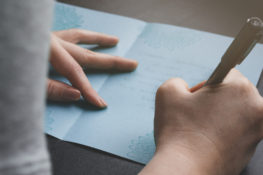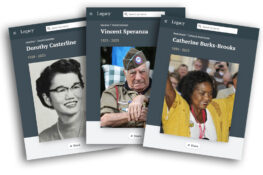Walter Nelson-Rees Obituary
From fall 1948 until summer of 1952 Walter attended Emory University in Atlanta, Georgia (dormitory counselor, laboratory assistant) graduating with a B.A. in 1951, premed, and an M.S. 1952, biology, (effects of oxygen under pressure on meiosis chromosomes in Tradescantia sp.); Phi Sigma, 1950; elected to Georgia Academy of Sciences, 1952; Association of South Eastern Biologists, 1952.
In 1953 he returned to the U.S.A. as an immigrant from Cuba, briefly worked as a salesman, then volunteered for the U.S. Army in New York City. Induction followed at Camp Kilmer, New Jersey, basic training at Ft. Dix, New Jersey, and then Walter was stationed as Scientific and Professional Personnel in the Chemical Corps at Dugway Proving Ground, Utah (April 1953 to January 1956, private to corporal S.P. 3 Biological Research Assistant, in biological program directed by the University of Utah, Salt Lake City). He was co-founder and participant in Skull Valley Players; Harvey, Light Up the Sky, Trip to Bountiful. On November 19, 1953 he was naturalized as a U.S. citizen in Salt Lake City and was granted a name change to Walter A. Nelson- Rees. On discharge, he was given a good conduct award and the National Defense Medal. For six months he attended the University of Utah (January to June 1956, laboratory aid to laboratory assistant, Departments of Genetics and Embryology).
In July 1956 Walter moved to Berkeley, California to attend the University. His mentor in the Department of Genetics was Cytogeneticist Professor Spencer Wharton Brown for whom Walter first worked as a laboratory technician then research assistant under National Science Foundation Grant to S.W. Brown. He defended his Ph. D. (sex determination in the mealy bug, cytological study) in June 1960 and received a National Institutes of Health postdoctoral fellowship spent largely on expedition to the Southwest, Mexico and Guatemala on an insect collecting, cytogenetic/taxonomic study of scale insects (with S. W. Brown, discovery of new species). At Berkeley, Walter was elected to Sigma Xi, founded Wild Type, a publication for Department of Genetics, and acted in Doctor’s Dilemma as Cutler Walpole. A Fulbright Research Scholarship was granted Walter, 1961-1962, for study at the Max Planck Institute for Marine Biology, Tübingen, Germany in the department of Professor Dr. Hans Bauer (microcinematography of normal and irradiated mitoses and meioses in Planococcus). During this year Walter lectured on his work in cytology at the Universities of Louvain and Liege, Belgium, and Padua, Pavia and Rome, Italy, and the Max Planck Institute for Biology, Tübingen, Germany.
Walter’s professional career extended from his return to the U.S. from Germany in late 1962 until October 11, 1981. During these years under contracts from the National Cancer Institute, National Institutes of Health, he helped design, staff and equip the Cell Culture Laboratory (Cell Culture Division) of the Naval Biological Laboratory (later Naval Bio-Sciences Laboratory), University of California, Berkeley, situated at the Naval Supply Center, Oakland, California. He began this as an Assistant Research Geneticist and Consultant, Associate Chief, and ended as the chief of the laboratory’s section of Cell Characterization, Propagation and Distribution. The laboratory closed in 1982 (the site is now a parking lot for semi-trailers).
During his years at this laboratory, Walter, aside from his research and authoring and co-authoring numerous publications was active in various capacities in the Tissue Culture Association (now Society for In Vitro Biology); American Association for Advancement of Science; Mammalian Cytology and Somatic Cell Genetics; Pacific Coast Virus Tumor Group; Advisory Committee, American Type Culture Collection; Organizing Committee XIII International Congress on Genetics; Special Virus Cancer Program, National Cancer Institute. He served on editorial boards of: Journal of American Veterinary Medical Association; Journal of the National Cancer Institute; Applied Microbiology; In Vitro, etc. He Served on Ph.D. dissertation and qualifying examination committees for students in Public Health, was appointed as Lecturer in School of Public Health on courses in Experimental Pathology; Advanced Microbiology; Virology and Zoology and participated in Training Grant of Doctoral Program in Infectious Diseases Research, School of Public Health. He was appointed adjunct faculty at the W. Alton Jones Cell Science Center, Lake Placid, New York 1977-78. At the conclusion of his career at the University of California, he retired as a Research Geneticist, the equivalent of Professor in the teaching faculty series.
In addition to presentation of research results at professional symposia, annual meetings and conferences, Walter, by invitation, participated at and presented research reports at laboratories in Chicago (Fermi), Brugge, Liege, Pavia, Bethesda, Albuquerque (Sandia), London (Imperial Cancer Research Fund); Porton Downs, England; Glasgow; Paris (College de France); Freiburg University; Oslo (Norsk Institutet); Stockholm; Munich (von Pettenkofer Institute); Heidelberg University; Moscow (five laboratories as guest of Profs. Helen Pogozianz, Viktor Zdanov, B.L. Astaurov) and Academia Nazionale dei Lincei, Rome, Italy. Professional consultations were extended to hundreds of recipients of cell cultures initiated or stored in the Cell Culture Laboratory.
Although his extensive publications dealt especially with chromosomal aspects of cells in culture and cell cross contamination, he is particularly associated with the publication of lists of dozens of cell cultures that were contaminated by HeLa cells, and were no longer what their originators or users thought they represented. He concentrated primarily on altered chromosomes that as a group served as cytological markers for HeLa contamination since these markers were always found in the bona fide HeLa cells.
After retiring form the University of California, Berkeley, he and his partner, James Coran, developed the Oakland-based WIM Fine Arts, specializing in buying and selling mostly historical paintings by Californians. They wrote and published a number of catalogs and books on the subject, supported exhibitions and actively participated in and contributed to art matters in the San Francisco Bay Area and California. In 1989 to 1990 they sold the painting portion of WIM Fine Arts and concentrated on their private collection by then numbering over nine hundred works. Sadly, this valuable collection along with their home and all their possessions were destroyed in the Oakland firestorm October 20, 1991.
Walter is still occasionally sought after for advice and consultation in matters related to cell culture contamination and sound laboratory practices (Tissue Culture Association, State of the Art Review Conference, Rockville, MD, 1983; Origins of HIV and the AIDS Epidemic, Royal Society, London, 2000). The Society of In Vitro Biology on May 25, 2004 presented him with the Distinguished Life Time Achievement Award for which he was justifiably proud.
Walter died in San Francisco on January 23, 2009 and is survived by his sister-in-law Maria, two nieces and two nephews and their families in Florida and by his domestic partner (since July 19, 1959) James L. Coran. His request is that there be no service and his ashes be scattered at sea.
Memories and Condolences
for Walter Nelson-Rees
How you can show support
Follow
Get email updates whenever changes are made.
Send flowers
Consider sending flowers.
Add photos
Share their life with photo memories.
Plant trees
Honor them by planting trees in their memory.
Donate in Memory
Make a donation in memory of your loved one.
Share this page
Invite other friends and family to visit the page.
0 Entries
Be the first to post a memory or condolences.
Make a Donation
in Walter Nelson-Rees's name
How to support Walter's loved ones

Should I Send Sympathy Flowers?
What kind of arrangement is appropriate, where should you send it, and when should you send an alternative?
Read more
What Should I Write in a Sympathy Card?
We'll help you find the right words to comfort your family member or loved one during this difficult time.
Read moreResources to help you cope with loss

How to Cope With Grief
Information and advice to help you cope with the death of someone important to you.
Read more
Estate Settlement Guide
If you’re in charge of handling the affairs for a recently deceased loved one, this guide offers a helpful checklist.
Read more
Obituaries, grief & privacy: Legacy’s news editor on NPR podcast
Legacy's Linnea Crowther discusses how families talk about causes of death in the obituaries they write.
Read moreWays to honor Walter Nelson-Rees's life and legacy

Obituary Examples
You may find these well-written obituary examples helpful as you write about your own family.
Read more
Obituary Templates – Customizable Examples and Samples
These free blank templates make writing an obituary faster and easier.
Read more
How Do I Write a Eulogy?
Some basic help and starters when you have to write a tribute to someone you love.
Read more





